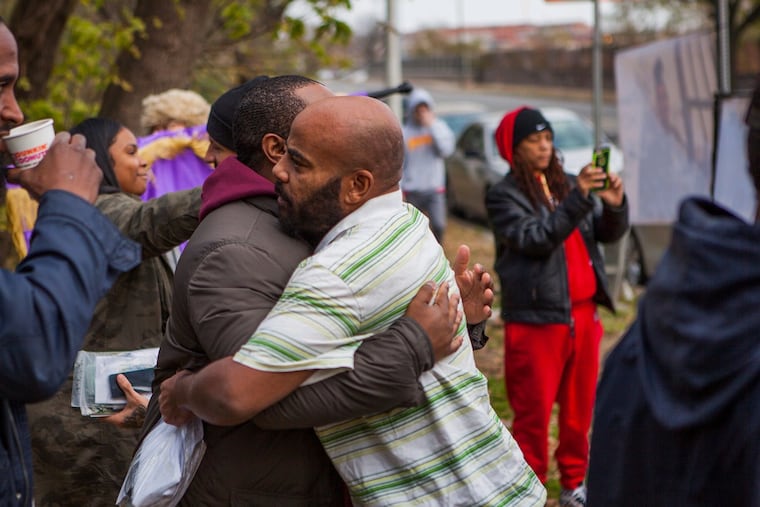In Philly, your race predicts whether you’ll be locked up or go free until trial, study says
Differences in ability to post bail account for one-third of the city’s race gap in pretrial detention.At $25,000 bail, white defendants are twice as likely to go free as black defendants while they fight their case.

Racial biases in the criminal justice system have been well-documented – from profiling by police during frisks and car stops, to charging, plea bargaining and sentencing.
But a new analysis reveals how wealth inequality exacerbates those systemic biases in Philadelphia — keeping black defendants in jail awaiting trial at a rate 25 percent higher than their white counterparts. According to Megan Stevenson, an assistant professor of law at George Mason University in Fairfax, Va., differences in ability (or willingness) to post bail account for one-third of the city’s race gap in pretrial detention.
Even though the courts and community groups have undertaken efforts to reduce the number of people held pretrial, 40 percent of defendants will remain in jail at least three days on bail as low as $1,000 — of which they would have to post just $100.
But when bail amounts are set higher, white defendants are far more likely than black counterparts to be able to scrape together the deposit needed to set them free. At $25,000 bail — or a deposit of $2,500 — white defendants are twice as likely to go free while they fight their case.
Stevenson, who has published a new paper on the misdemeanor system in Philadelphia and other jurisdictions with University of Georgia law professor Sandra Mason, spoke with The Inquirer about her ongoing research on the issue and what it means for racial justice in Philadelphia. The conversation has been edited for length and clarity.
At very low bail amounts, your research appears to show, white defendants actually bailed out at a lower rate than black defendants. Can you explain?
In Philadelphia, if a person is held on a detainer, basically even if they paid their bail, they couldn’t get out anyway because they have some sort of hold on them due to being on probation or parole for another case, and they can only get credit for time served if they are held on monetary bail. So at these super-low amounts, it’s a combination of people not being able to pay because they can’t afford it and not paying because even if they did pay, they wouldn’t be able to get out.
Once you get up to bails of about $5,000, though, and you have more than 50 percent of defendants detained, that is no longer really an issue. So what you have here is more than 50 percent of defendants are unable to come up with $500 to pay their way out. And when you look at bail deposits of about $1,000 or more — on bails of $10,000 — black defendants are about 10 to 15 percentage points less likely to post than white defendants with the same bail amount.
We know that race and wealth are correlated in this country. Black people on average have less wealth, lower incomes, potentially less access to credit. So the use of monetary bail can translate into racial disparities in who gets detained. Even if the judges aren’t taking race into account when they set bail, you can have racial disparities resulting because of disparate abilities to post bail.
Other research you’ve done shows that being locked up pretrial then correlates with many other disadvantages: a 42 percent increase in sentence length and a 13 percent increase in the rate of conviction. Are there other ripple effects?
Not just correlates — my research and other research has shown that being detained pretrial causes an increase in the likelihood of pleading guilty, an increase in the expected sentence length, an increase in the amount of court fees a defendant is liable to have to pay, as well as potentially destabilizing longer-term effects, in terms of labor market participation and so forth.
And Philadelphia court costs, at a median of $500, were the highest of any jurisdiction you looked at in your study of misdemeanors. What’s the impact of that?
This is $500 to a group of people who, only about half of them were able to come up with $500 to be able to pay bail. So $500 is a lot of money to a lot of people. The repayment rates are not that high. Currently there’s a lot of people that are just in debt to the criminal justice system in Philadelphia. For a couple years, Philadelphia hired a collection agency and started aggressively going after people who owed the courts money. They ended that a few years back because, one, it’s blood from a stone; people don’t have the money. But also their records were of such abysmal quality they couldn’t really [verify] the demands they were making. …. They stopped pursuing it as aggressively as they once were, but it’s not insignificant for a number of people to have this cost, whether they pay it or whether they simply remain in debt to the court system.
What do you think of community bail funds as a solution?
They can only do so much. I think bail funds are interesting. I would rather see more fundamental change.